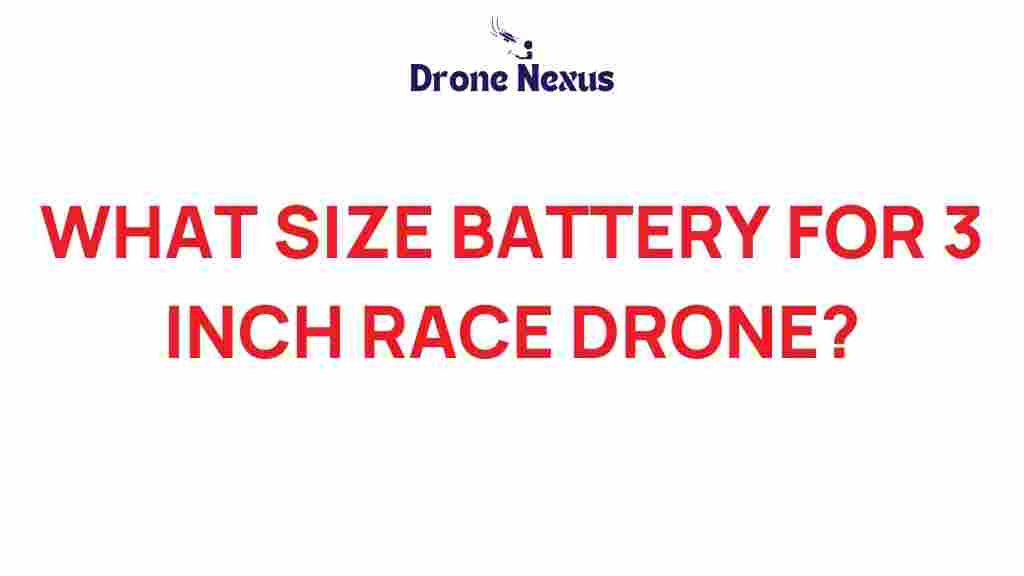Unveiling the Ideal Battery Size for Your 3-Inch Race Drone
Choosing the right battery size for your 3-inch race drone is crucial for maximizing performance, flight time, and overall experience. In this article, we will delve into the factors that influence the optimal battery size, how to select the right one, and some troubleshooting tips that can help you get the most out of your drone. Understanding battery size is essential for any drone enthusiast looking to enhance their flying experience.
Understanding Battery Size
The term “battery size” refers to the physical dimensions and capacity of the battery used in a drone. For 3-inch race drones, the right battery size is typically measured in terms of:
- Voltage (V): This indicates the power output of the battery.
- Capacity (mAh): This measures how much energy the battery can store. A higher mAh means a longer flight time, but it also adds weight.
- Weight: Heavier batteries can reduce flight performance and maneuverability.
When selecting the ideal battery size, you must balance these three elements to achieve optimal performance without overloading your drone.
Factors Influencing Battery Size
Several factors play a crucial role in determining the ideal battery size for your 3-inch race drone:
- Drone Weight: Heavier drones require larger batteries to maintain flight time. Ensure that your battery size does not exceed the drone’s weight limits.
- Flight Time: If you aim for extended flight times, a larger capacity battery may be necessary. However, it is essential to consider the trade-off between weight and capacity.
- Flight Style: Aggressive flying styles demand more power, which can impact battery size and type.
- Motor Specifications: The motors’ requirements will also dictate the battery voltage and capacity needed to achieve optimal performance.
- Weather Conditions: Wind and temperature can affect battery performance; thus, having the right battery size is vital.
Selecting the Right Battery Size
Now that you understand the key factors influencing battery size, follow these steps to select the ideal battery for your 3-inch race drone:
Step 1: Determine Your Drone’s Weight
Weigh your drone without the battery. This will help you understand how much weight your battery can add without compromising performance.
Step 2: Evaluate Your Flight Needs
Decide how long you want to fly. For example, if you want a flight time of around 5-7 minutes, a battery with a capacity of 450-850mAh is typically suitable for 3-inch race drones.
Step 3: Choose the Voltage
The most common battery configurations for 3-inch race drones are:
- 3S (11.1V)
- 4S (14.8V)
Generally, a 4S battery provides more power and is preferred for racing. However, ensure that your drone’s motors and electronic speed controllers (ESC) can handle the higher voltage.
Step 4: Assess the Weight of the Battery
After determining the required voltage and capacity, weigh the battery. Ensure that your chosen battery does not exceed the maximum weight limit for your drone to maintain optimal flight characteristics.
Step 5: Read Reviews and Recommendations
Research different battery brands and types. Look for user reviews and recommendations in forums, such as RC Groups, to find reliable battery options for your specific drone model.
Common Battery Sizes for 3-Inch Race Drones
Here are some common battery sizes that work well with 3-inch race drones:
- 3S 450mAh: Ideal for lightweight setups, providing a good balance of power and flight time.
- 4S 450mAh: Great for aggressive flying, offering higher voltage and quicker response times.
- 3S 850mAh: Suitable for longer flight times but may add extra weight.
- 4S 850mAh: Perfect for extended racing sessions with sufficient thrust.
Battery Maintenance Tips
To maximize the lifespan and performance of your drone batteries, consider the following maintenance tips:
- Charge Properly: Use a quality charger designed for LiPo batteries, and never overcharge.
- Storage: Store batteries at a partial charge (around 3.8V per cell) to prolong their lifespan.
- Temperature: Avoid exposing batteries to extreme temperatures, both hot and cold.
- Inspection: Regularly check batteries for swelling, damage, or any signs of wear.
Troubleshooting Tips
Even with the right battery size, issues can arise. Here are some troubleshooting tips to help you resolve common battery-related problems:
- Short Flight Times: If you’re not getting the expected flight time, check the battery’s capacity and ensure it’s adequately charged.
- Battery Overheating: If the battery becomes hot during flight, reduce the load on the drone or switch to a lower capacity battery.
- Inconsistent Power Delivery: If the drone is not responsive, inspect the battery connections and ensure compatibility with your ESC and motors.
Conclusion
Selecting the ideal battery size for your 3-inch race drone is essential for ensuring a thrilling and optimal flying experience. By understanding the key factors that influence battery size, evaluating your drone’s weight and flight needs, and considering common battery sizes, you can make an informed decision that enhances your racing capabilities.
Remember to maintain your batteries properly and troubleshoot any issues that arise to ensure longevity and performance. As you delve deeper into the world of drone racing, you’ll find that the right battery size plays a pivotal role in achieving your flying goals.
For further tips and discussions on drone racing, check out our other articles on drone technology.
This article is in the category Applications and created by DroneNexus Team
